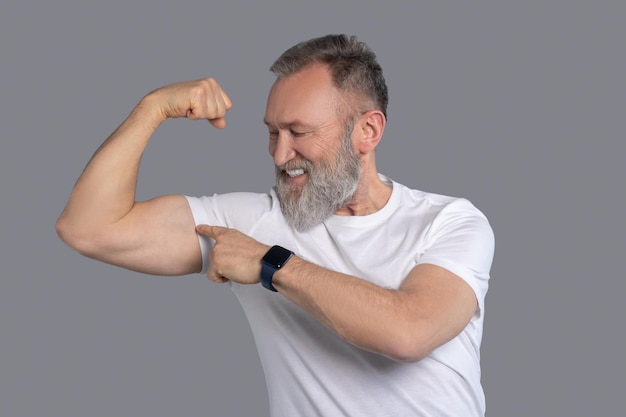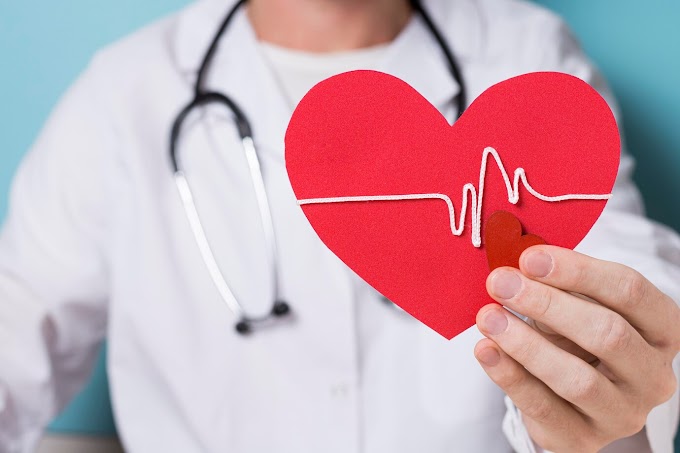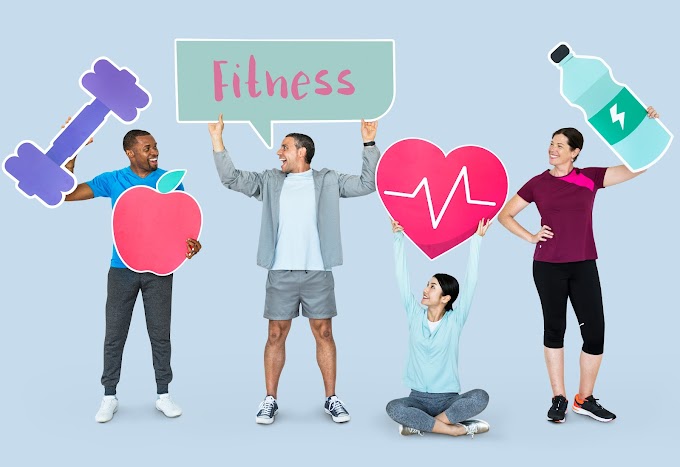
Post topics :
1 - Healthy diet:
2 - Getting active:
3 - Controlling blood sugar:
4 - Watch your cholesterol:
5 - Weight management
6 - Monitor blood pressure
7 - Live smoke free
2 - Getting active:
3 - Controlling blood sugar:
4 - Watch your cholesterol:
5 - Weight management
6 - Monitor blood pressure
7 - Live smoke free
Step1 - Healthy diet:

Your diet should consist of a variety of fruits and vegetables, whole grains, lean proteins like fish and skinless chicken, nuts and legumes, nonfat or low fat dairy and fat from plant-based sources like oils. Now, it's also important to remember that it's not also what you eat, but how much of it you eat. So it's important to have good portion controls of these healthy components of your diet. Margie, do you have any fun tools that could help us stick to a heart healthy diet? - I do, you know a heart healthy diet is more plant-based and I know my husband and I, although we're pretty healthy eaters, kind of came to the realization this year that our whole life, we've been taught to either have the meat as the center of the plate or carbohydrates. For example, I grew up Italian so then the whole plate would be a big plate of pasta or the whole, if it's Chinese food, a big plate of rice or it would be what meat are we having today? And we'd say steak, or we'd say pork chop and then that would be the star and everything else around the plate was to complicate to compliment the center, which was meat or carbs. And so it's can seem complicated actually
but we want to make it simple and say, if you could start making your plate more plant forward with at least half of the plate vegetables, getting your heart or your vegetables sourced fats like nuts, if you go ahead and have fruits and whole grains, you're gonna be well on your way to a heart healthy diet. It's really good to try some new heart-healthy or plant based recipes and one of my favorite tools is "Forks Over Knives. " They have a website and also every season there, they have like the fall season for seasonal vegetables, different recipes and you could find that in your grocery store, this magazine, you could also go on forksoverknives. com. - Fantastic, alight. I'm Italian too, so I know what you mean about the pasta and bread, pasta and bread, that's all we ever eat. All right.
Step 2 - Getting active:

And it's addicting and it's good. - Right, so the second step to a healthy heart is getting active. So activity has a whole lot of great benefits. It lowers blood pressure, it improves your cholesterol, it prevents bone loss, it helps some people quit smoking, it helps manage stress, it promotes a really good positive attitude and helps with sleep, it gives you great self-confidence and is a fun way to spend some time with family. The American Heart Association recommends 150 minutes of moderate intensity exercise a week. Now that may seem like a big number, but if you think about it and break it down, for most of us to be able to do. And what's moderate intensity exercise? That could be a brisk walk, dancing, gardening, household chores, walking your dog. How do you know if you're doing moderate intensity exercise? Try the talk test. If you're walking and you're able to talk but you can't sing, then that means you're going at a good rate. You're doing exercise that's really gonna benefit your heart. Now, a couple of more tips that is important, it's good if you schedule your exercise, because if you schedule it, you're more likely to do it. Schedule a walk on your break for 15 minutes with your coworker every day, go for a bike ride after work with your kids. Also with COVID, we've all been kind of sitting home and a lot of us can't get out. Well, you can get a little exercise at home as well. If you're watching TV and you see the commercial comes on, every time a commercial comes on, get up and walk around your house for a minute or two. That 30 minutes doesn't have to be all together,
it can be in bits and pieces throughout the day but the goal is to get at least 30 minutes a day. Margie, do you have anything that can help us get active, get that exercise on? - Yeah, I do. You know, again, similar to going ahead and eating more heart-healthy where you have to change your family food culture to be more plant-based and less of the processed foods and the same thing with exercise, it's not going to be like you live your life and then you exercise, being active needed to become part of your household or your family culture. And I know my husband and I have, we have done that is every single day we go for walks and having a dog really helps so that, that dog helps and I don't wanna be like, oh, I have to exercise, try and add something fun. We love to kayak, we love to go hiking and also, my favorite thing is gardening and even last night, as soon as I got home, I spent 30 minutes outside planting some seeds. So find the things you love and make it again who you are as a family, not just an additional thing to add to your schedule. That being said, you cannot out exercise a bad diet. So sometimes we think, oh, I went for a 30 minute walk, I burned some calories. Just to let you know, I'm, being a small woman, even if I do a brisk walk, that's 3. 5 to four miles per hour, I only burn about 300 or 350 calories. So that being said, if I have one Snickers bar, I've already inhaled all the sugar and fat calories that would take me to go ahead and walk a whole hour. You could take it down and eat it much quicker than you could exercise it off. So again, unless you are a marathon runner or exercise really long distances, you can't count on your exercise alone to burn up those extra calories. - Fair enough. Dang it, I love my Snickers bars. (laughing) All right, so our next, our next step towards a happy heart is controlling your blood sugar.
Step 3 - Controlling blood sugar:

Most of the food we eat is turned into glucose or blood sugar and we use that for energy in our body and over time, high sugars can damage our heart, our kidneys, our eyes and our nerves. It's really important to understand that it's not just people with diabetes who have to worry about their blood sugars, people like you and me, we need to worry about our blood sugars. The more sugars you eat, the more insulin you need to break down those sugars and as a result, a lot of insulin can cause the body to hold onto calories. Also, if, normal blood sugar is less than a hundred, if you ingest just above that hundred, it could still start causing damage to your kidneys and to your heart. So it's really important to know what your blood sugar is. If you don't, that's okay. It's really important to work with your primary carer to have someone monitoring your blood sugars on a regular basis and if they do tend to be elevated, intervene in some kind of way, whether it be through lifestyle modification or through medication. Margie, what are your thoughts on things we can do to eat less sugar? - You know, that's a really great point that you made that an average blood sugar over 100 is pre-diabetes and average blood sugar over 126 is diabetes. I was really shocked, although I exercise and I manage my weight, I am actually living with pre-diabetes. And that means that currently, my blood sugars are high enough that it could be doing damage to my small blood vessels in my eyes and my kidneys and actually my major on blood vessels and arteries as well and I've had to watch it. I think for myself, like many people, the first thing that we need to look at in terms of blood sugars is if we have too many carbs at one time. So if we have on a regular basis, more often than not, if we have this big carb based meals, the spaghetti, the rice, for example,
our body can not break that down within two hours back to a normal blood sugar. So one of the first things you can do to manage your blood sugar is not to eat too many carbs at one time, in one meal and make sure you've balanced the carbohydrate intake with non-starchy vegetables and lean proteins. So that's one of the things to look at. Another thing for me is I have a sweet tooth and I think that if I'm here at work or even at home, I'm like, give me some sweet, I just need a little something. And so part of it is realizing what our needs are and what we want and then finding something that fits within a healthy plan. Extra dark chocolate, 80% darker or more actually is full of antioxidants and not that much sugar comparatively. I found this a great Grocery Outlet, which I love And it's the Big Chard chocolates and six pieces is 160 calories. And in six pieces altogether has 15 grams of carbs, which is the same amount of carbs as a piece of bread, so six is the serving for that, I have three and it's dark chocolate and it satisfies that sweet tooth without a lot of extra calories and sugar. And so again, look at that sweet tooth and manage it in ways that aren't as harmful to the body. Another thing is seasonal produce. I love the fact that every season, we have different produce and so we get a wide variety. Right now, it's mainly citrus season so enjoyed Mandarin oranges, enjoy regular oranges, go to your farmer's markets and get the fruit in season and that can become your sweet. - I do like citrus, but I got to admit, I like the chocolate better. The fourth step to a happy heart
Step 4 - Watch your cholesterol:

Is controlling your cholesterol. So high cholesterol contributes to plaque, which in clog up your arteries and lead to heart disease and stroke. When you control your cholesterol, you're giving your arteries the best chance to stay clear of blockages, which will prevent future heart attacks, which is really important. Now a normal blood cholesterol level is less than 200 unless you have a history of coronary artery disease then you want to keep it a little lower. - Margie, do you have any tools that can help us keep our cholesterol down? Keep those numbers good? - Yeah, I did want to make the point that cholesterol is actually a good thing. A body makes the cholesterol itself to digest fat and it's a real important part of metabolism and even the LVL, which people think is bad cholesterol, your body makes that too and so in itself, we need it for metabolism to be healthy. So what happens though, is our body makes all that it needs, so where we get into trouble is when we then eat animal products, other animals make cholesterol to digest fat. So when we eat the fat from animal sources, like fat in milk products and also fat and meat products, we're eating another animal's cholesterol and we have our own and we're taking on more and not everyone's bodies could go ahead and handle, going ahead and digesting all the additional cholesterol. So it is a good thing, too much is not a good thing. So some tools to manage that is to realize that the intention of having animal products is in smaller quantities. If you look at something called the blue zones and that's where people live for well over a hundred years, they do even have pork and everything but the base of their diet is plant-based, the base of their diet is more beans, the place of their diet is more whole grains, local fruits and vegetables.
And so the tips are, again, just start thinking of our meat products and our higher fat milk products as condiments, a small addition to add flavor and not the star of our meals. And don't forget some, also some really inexpensive ways to go ahead and get protein without cholesterol and again, fish like tuna canned in water is terrific. Fish does not have cholesterol, this is a great tip. Also adding more beans is a great way to go ahead and get protein without getting the fat from animal products. And so, there are inexpensive forms of protein that you do not have to worry about cholesterol. I love cheese, I love cream cheese. So little trick that I have, a little hack is we have The Laughing Cow cheese, well there's Laughing Cow light, which is a very low in saturated fat and cholesterol on the lower side, lower than cream cheese and other spreads. So you could occasionally you could use this or even use avocado or salsa on foods as opposed to adding the additional butter or cream cheese. So try these tips, they may help you. - I love it. So just to review, we've gone over the first four steps to a happy heart. Eating a heart healthy diet, engaging in exercise, monitoring your blood sugar and your cholesterol. So let's move on to number five. Number five is maintaining a healthy weight.
Step 5 - Weight management

So when you shed extra fat and unnecessary pounds, your reduce the burden on your body, right? So there's less work for your heart, your lungs, your blood vessels and your skeleton. You do not need to lose a huge amount of weight to make a difference in your health, something as simple as three to five pounds can be medically significant. It's also important to remember, a big portion of weight control has to do with calories in calories out. So it's good to kind of keep an eye on how many calories you're taking in and how much, how many calories are going out via exercise. A really important number to know is your body mass index which is a number that, it's a numerical value that gives you an idea of your weight in relation to your height. So it can help you determine if you're at a healthy weight or if you're at a weight that may require a little bit of weight loss. There are lots of apps on the internet to help calculate your BMI or you can just talk to your primary care provider and figure out what your BMI is and figure out a plan from there. Now, a normal BMI runs between 18. 9 and 24. 9. Margie, do you have any thoughts or any ideas on what we could do to help manage our weight? Cause I know a lot of us have put on the COVID 19, 19 pounds,
So I could use all the tools you got. - You know, that's a really good point. Research has shown that the average person has gained 19 pounds during COVID, which is amazing to me and this is for people that typically have not had weight problems in the past. So just know that if you're dealing with COVID, the COVID 19 or 20, it is a real thing, it's stress, it's our lifestyle has totally changed and you could turn this around. So many people who've had more difficulty with weight throughout their lives, now they're in a situation that's heightening, they're free if they have an eating disorder or they have addictive overeating, many people, if you've struggled with weight in the past, all of a sudden it's being, that intensity is being racked up and it's worse for you right now.
So just know that we can turn it around and there's light at the end of the tunnel here and so that's going ahead and making sure that you have the tools to go ahead and be successful as you address what's happening with your weight. And once again, I'm drilling it down into you that the most important thing is to really eat more plant-based, making sure you're getting more vegetables, most people don't get enough. You're getting more, two to three pieces of fruit a day, whole grains, fish, beans, lean proteins and when you eat that way, you're actually increasing the volume of food that you get and when you start cutting out the white sugar and the white flour and the processed foods, you will not be getting, not be as hungry because you're actually, you are consuming a large amount of food. I don't want you to go hungry, it's not about not eating or skipping meals. So a tip, I also wanna point out that is working here in cardiac rehabilitation is we know that the keto diet is really popular.
Yeah, that's true. - Yeah, isn't it? Don't you hear about that too? - I get asked by patients all the time about it. - Yeah, so, even though the keto is a name of a trendy diet, eating keto-genically only means that you're eating low enough carbs and more protein and hopefully plant-based fats that your body isn't going ahead and burning the ready available carbohydrates or sugars in your body, it's being forced to burn fat and so that's all that ketogenic is and it's a scientific term not just a name for a popular diet. You hear the popular keto diet just saying have fat bombs, it's something they call what they drink in the morning with ghee or half and half and we've had actually had patients come in here with fatty liver disease that actually resulted from months on a keto diet, that they kind of ate all the saturated fat they could all day long and didn't worry about that. And so much of that weight loss ends up being water weight. And so for heart health, if you choose to eat more keto-genically, meaning less carbs, more lean proteins, for example more nuts, more avocado, for example, that's okay but I still ask you to go ahead and limit the saturated fats that we would have patients here in cardiac rehab that have come in, lost a lot of weight on keno
only then to find out their were completely clogged and having to have a procedure. So eat keto- genially if that's what you work out with you and your doctor but again, we still wanna go ahead and avoid a very high saturated fat diet, a diet that's high in animal fats. And I do ask you that once you make a decision that weight loss is something you wanna do, we do not want to gain weight and lose weight and gain weight and lose that weight, whenever you lose, even if you try not to, you lose muscle mass, we wanna increase your muscle mass. What we wanna do is go ahead and lose it once and then build the muscle mass back up again cause again, if you lose, you're gonna lose some muscle, when you gain more back again, you always gain more fat. So those yo-yo dieting people over time, not only are they heavy but their percent muscle declines over time and I don't want that for you. So to go ahead and find a really a lifestyle eating plan that best supports your whole life, I ask that you get support and I think Genevieve is gonna put up, there it is, it's up there right now. There are some avenues of support that I recommend. One is you UC Davis Living Well through the health management education program has a weight management class and they also have other classes like smoking cessation and stress management but one of the least expensive things for you to do to address weight and get support is call that number and then ask to join one of their classes and I think it's on Zoom right now.
Terrific curriculum, wonderful registered dieticians that teach that class. Another, an app that's newer on the market, a phone app it's called Noom. I've heard their price is $150 for six months and also I've heard $59 a month, I think it depends if you get a special but it's a place where you go ahead and write down your food intake every single day, they have you work through like behavioral aspects of over eating, you get to go ahead and know, they have recipes and tips for weight loss, for lifestyle change and they also have a coach that you go ahead and communicate with on a regular basis. That is a food recording app and we find that people who write down their food intake are 80% more likely to lose weight and that's because writing it down, you're having to be mindful. I track my food intake on MyFitnessPal and some days I think, oh, I really blew it and I look at the app and I'm like, oh I'm only like 200 calories off and I go for an extra walk. So sometimes it tells me that I didn't do as bad as I thought I did. So it helps us just look at it, we know where we're at and then steer our choices based on what that app is telling us. So again, the next one is MyFitnessPal. It is free, I use the free app, you can pay, I think it's $15 a month, I've never done that before. I like MyFitnessPal, the free version that you just get a lot of ads but it's a great tool and I would probably say that the standard of the best known diet for sale that we've found is Weight Watchers and it's really sound and it teaches balanced eating and it teaches eating more calorie, not as calorie dense foods.
And so Weight Watchers is another great go-to. Don't go it alone, please go ahead and find a really good program for you to follow, find your registered dietician and in addition, try and find a support person, whether it's a best friend that will encourage you or a spouse or a partner, again, weight management is difficult and I want you to have a team to cheer you on. - And I think it's also important to point out that everybody's different, right? Everybody's mind and body works differently so what may work for one person may not work for another and I think that's why Margie put up these different resources because weight Watchers might be better for you or if you're more into details, MyFitnessPal might be for you. If you're more of an emotional eater, perhaps Noom is better. So just keep that in mind, if you're trying any of these or any other weight loss programs, if it doesn't work, don't give up, you just got to find the one that works best for you. All right, let's move on to our sixth step to a happy heart
Step 6 - Monitor blood pressure:

And that's monitoring your blood pressure. High blood pressure is a major risk factor for heart disease and stroke. When your blood pressure stays within healthy ranges, you reduce the strain on your heart, your arteries and your kidneys, which keeps you healthier longer, right? So basically if you think about your arteries and veins as tunnels and the heart is pumping blood through these tunnels, if the tunnels start to narrow, like they do when you have high blood pressure, it's harder for the blood to get to your organs, to your kidneys, to your heart and then you end up with kidney failure and heart failure. So it's really important, to keep those tunnels open, keep those arteries nice and open. So the normal blood pressure or where we'd like you to be at is less than 120 over 80. And if you can either monitor your blood pressure at home or once again, work with your primary carer. Visit them a couple of times a year, have your blood pressure monitored and it's really important to understand that high blood pressure can be a silent killer. You can have really high blood pressure and not know it, you may not have any symptoms but the damage is still being done to your organs. So it's really important to see your primary care regularly, have it monitored and if it is elevated, definitely have some kind of intervention, whether it be lifestyle modification or medication. Margie, any ideas on how we can keep that blood pressure down? - Yeah, definitely. So the dash diet is a diet that actually promotes control of blood pressure and really the center of that core, that diet is more vegetables, whole foods, more fruits, whole grains, and lean proteins. And so again, that healthy eating is gonna help you manage your blood pressure. We also talk about stress management as part of blood pressure. You know, if you're not eating well, even if you don't realize it, it's affecting your body's ability to manage stress. So, through eating a lot of white flour foods, white sugar foods, fast food, just to get through our day and manage and not taking time for healthy meal preparation, we probably have too much on our plate and actually the unhealthy food choices aren't helping the problem of stress, it's actually hindering and making your health worse. So taking the time for healthy eating is part of stress management and it's part of blood pressure control. Everything in our body connects the other, it all works together, it's not separate compartments. So I want you to feel good about yourself and eventually when you get healthy, it's hard at first, you'll feel better and hopefully, it'll lower your blood pressure. - And I think that's another, oh, I'm sorry, Margie, I didn't mean to we did cut you off. I was just gonna say, I think it's important to realize all these steps are kind of interactive, right? 'Cause when you exercise and eat right, your blood pressure will be better, your blood glucose will be better, your blood cholesterol will be better, they're all kind of interlinked. So it's when you're doing one, you may not just be doing one, you may be doing multiple at the same time.
- Exactly and you know, sometimes we go to different doctors for different things and we forget that it's all correlated, and so if one part of our body's out of whack, other parts, are too. So part of that with blood pressure is also sodium intake. Now, if you think about it, in the past, in years past decades ago, sodium was really just added to to cure meats when we couldn't refrigerate. So then over time, with more processed foods, we're busy people, we don't want to have to prepare our foods, we wanna go to the grocery store and pick up a box mix and there's sodium added as a preservative. So whenever we have ready packed foods, processed foods, we're getting additional sodium. Also whenever many people cook with sodium, it does enhance the flavor of foods so that adds more sodium and then sometimes at the table, when we season and we season with salt or sodium. You know our body really only needs like one to two teaspoons a day and yet we get a lot more than we need. I'm not worried about the sodium that naturally is occurring in some fruit, some vegetables, you know what we'll say? It has a teeny bit of sodium. I am concerned about the processed foods and the seasoning. So one thing that I have learned is that even over the last year or so when I've been eating more plant-based, I'm eating a lot more spices and herbs and spices. So there's a lot of flavors other than salt. There's also, Basil, there's oregano, herbs and spices. Some of my favorite ones are, well, cinnamon's one but dill weed and also I have a celery stick here. So those dried herbs and spices, there's a lot of fresh herbs and spices, there's vinegars that add flavor, there's lemon, adding lemon to food, adding lime to food, there's a garlic and there's onions. And so as opposed to having more a single note, add sodium. Really think of, how could I really pop in and enhance the flavor of my foods with herbs and spices and other fruits, other vegetables, that add flavor and actually, every single plant that you add in your diet adds additional antioxidants that help your health overall. So put down the salt shaker and experiment with some other herbs and spices and other ways to season your food. - All right. All right everybody, we've reached step seven, the last one and that's live smoke-free.
Step 7 - Live smoke free:

Smoking is one is the number one preventable cause of death in the United States and smokers have a much higher risk of developing heart disease. If you smoke, quitting is the best thing you can do. Within one year, one year of quitting, your risk of heart disease goes down by 50%, which is huge, that's really huge in the heart world. Quitting smoking can also lead to lower blood pressure and heart rate, better circulation and reduction of coronary artery disease. In other words, your arteries aren't gonna clog up as quickly if you stop smoking. Margie, do you have any tools that can help us kick the habit? - You know what? I do have a tool in my toolbox. (laughing) And boom goes to the tool bag. So I have my little container here of my cucumbers, a little cucumber snacks, there you go. So I think you realized that giving up smoking is in the number one thing, even above weight loss for heart health. And so if you are dealing with weight and smoking, if you had to choose, smoking would be a great one to look at. We do find though that smoking is a stress reducer. It does change our body chemistry and actually the cells in our body and so once you get rid of that nicotine, you are gonna go ahead and those cells, you know at times we think, oh, we don't have the self-control, actually it's biological, the cells in our body have changed. So when you take away the nicotine, it's not that you don't have willpower, it's actually those synapses in your cells are going like where's the nicotine, where's the nicotine? And it wants something else. So we find many, often when people go through smoking cessation, they gain weight. If you gain weight, it's okay, we can take it off over time. So the most important thing is to work to go ahead and get rid of the smoking. But one thing I wanna make sure that you understand is once your biological being no longer has the nicotine, it's gonna look for something else to feed it, another drug and be cautious about adding in too much caffeine
or adding in sugars or adding in white flour and carbs that are just gonna feed that addiction and you're going to have a cross addiction. For those cells to truly heal over the time and not have cravings, They just need to be and you need some time, those cells need time to heal and that's gonna take some time. So a tip is just knowing that you're not gonna feel great, that you're gonna have cravings. You're going to miss going like this, going like this. You're gonna miss the stress reduction part. Try and have things like cucumbers or carrot sticks or celery sticks or pretzels, healthy snacks around that you could go ahead and replace when you would normally have a cigarette. Maybe you used to smoke after dinner every single day, so then maybe you go ahead and you add a walk, so you get your exercise and then you go ahead and make, allow yourself to have some carrots or a bag of pretzels. So again, realize you are gonna be getting rid of something and then you choose what you're gonna to replace it with and I'm hoping that you could replace it with healthy options. - I think with stopping smoking, like you said, it's not the easiest habit to break. I think support is a big component of it. UC Davis has a wonderful smoking cessation program that's multifaceted. It involves the nicotine patches, sometimes medication but more importantly as a support group to kind of help you know that there are other people that are going through the same difficulties as well. And I think that's, I think social support is important for any change, no matter what we do but especially something as significant as smoking. - [Margie] Definitely. - Well guys, that completes it. Seven steps to a happy heart. First I'd like to thank Margie for joining us and her tool bag with all her great tools that will help us make all these changes. For more information about the simple seven

.jpg)
.jpg)
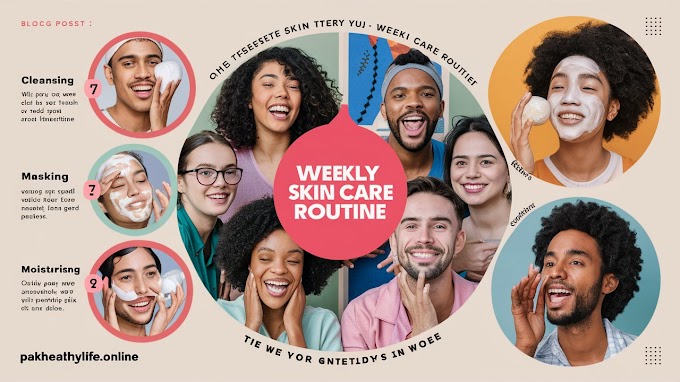
.jpg)
.jpg)
.jpg)

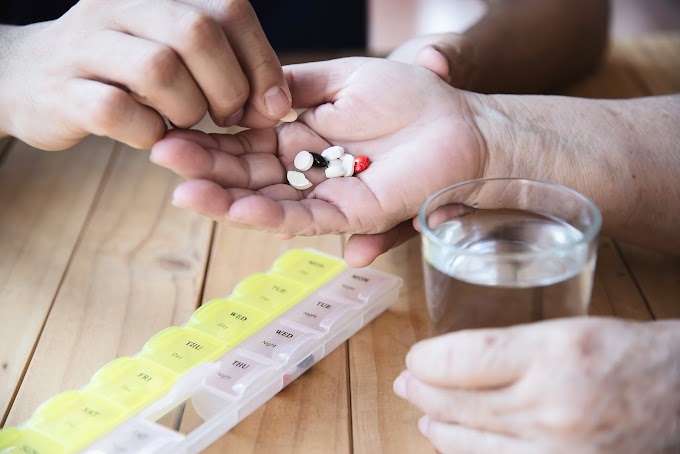
.jpg)

